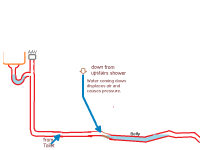Tripp Knightly
New Member
(This isn’t just toilet related, so posting here.)
I’m half expecting some of you to tell me I’m nuts but I’ll tell you anyway. I have a downstairs (ground level) toilet. If I close the seat cover say overnight and open it: pronounced sewer gas. If somebody right above upstairs showers (drain uses same vent stack): sewer gas. The stink really is in the bowl not at the base of toilet, dispelling I think a wax ring / flange issue. The toilet feels solidly mounted and the problem has emerged in the last year or so only; plumber install ~ 5 yrs ago. Proximate p-traps are all primed, in fact all p-traps are (all drains in use). Sometimes it seems like the American Standard 1.28 gpf toilet doesn’t flush well on the low vol flush.
So I’m wondering: can sewer gas permeate straight into the bowl through the water- it’s not like I see bubbles but maybe it won’t work that way. I have an HD endoscope so I can rig up something to look at the vent stack from the roof.
I’m half expecting some of you to tell me I’m nuts but I’ll tell you anyway. I have a downstairs (ground level) toilet. If I close the seat cover say overnight and open it: pronounced sewer gas. If somebody right above upstairs showers (drain uses same vent stack): sewer gas. The stink really is in the bowl not at the base of toilet, dispelling I think a wax ring / flange issue. The toilet feels solidly mounted and the problem has emerged in the last year or so only; plumber install ~ 5 yrs ago. Proximate p-traps are all primed, in fact all p-traps are (all drains in use). Sometimes it seems like the American Standard 1.28 gpf toilet doesn’t flush well on the low vol flush.
So I’m wondering: can sewer gas permeate straight into the bowl through the water- it’s not like I see bubbles but maybe it won’t work that way. I have an HD endoscope so I can rig up something to look at the vent stack from the roof.

